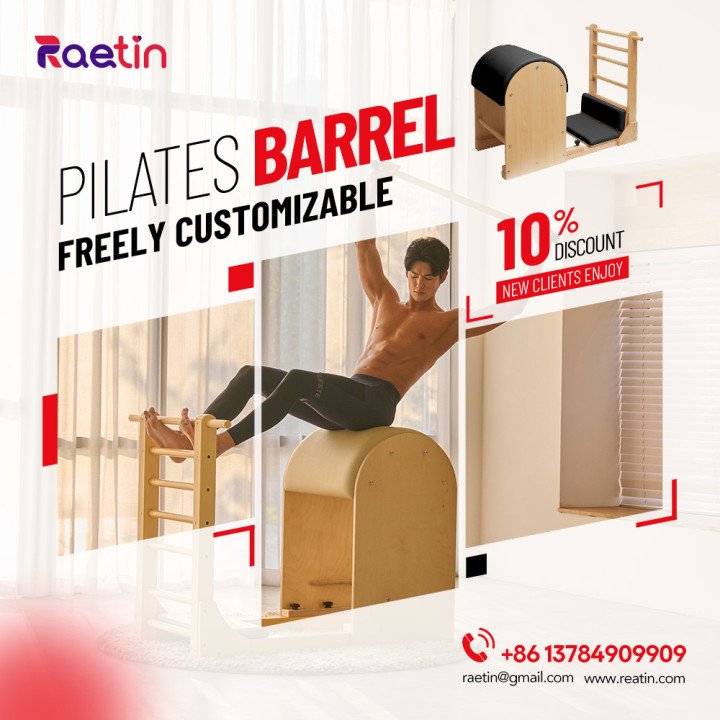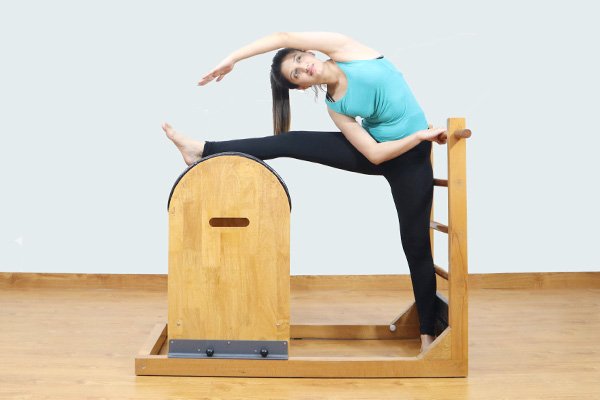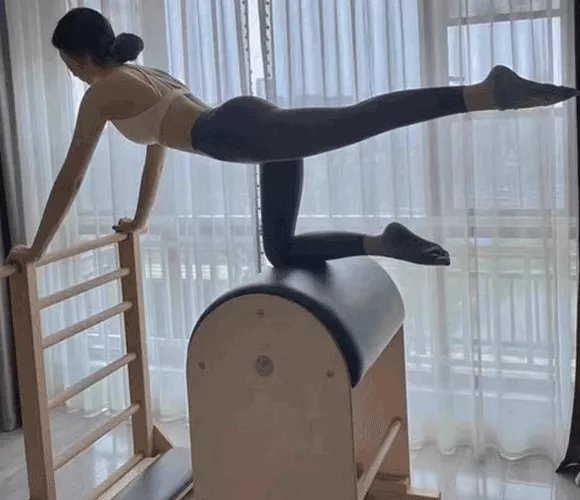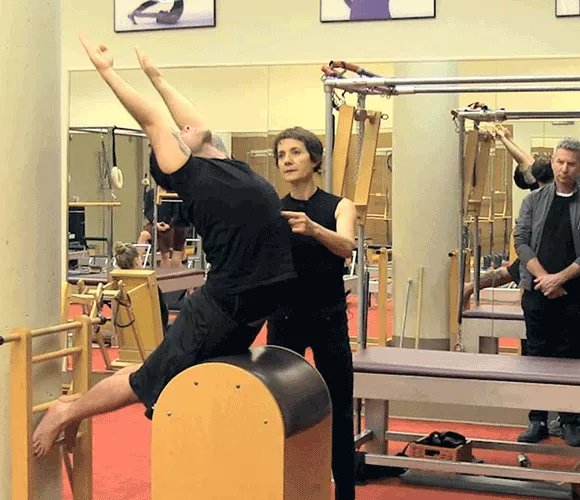
Introduction to the Ladder Barrel: A Historical Overview
The Ladder Barrel is a versatile piece of equipment used in Pilates and other fitness practices, known for its ability to enhance core strength, flexibility, and overall body alignment. Its history is deeply intertwined with the development of the Pilates method, which was created by Joseph Pilates in the early 20th century. Originally, Pilates designed his exercises and apparatus to help rehabilitate injured soldiers during World War I, using springs from hospital beds and other available materials. Over time, as the Pilates method evolved, so did the equipment, including the Ladder Barrel.
The Functionality of the Ladder Barrel
The Ladder Barrel is primarily used to perform a variety of Pilates exercises that focus on improving flexibility, strengthening the core, and enhancing the body’s overall alignment. This piece of equipment is particularly effective for working on spinal extension, flexion, and rotation, as well as for opening up the chest and shoulders. It provides a stable yet flexible platform that can be adjusted to accommodate users of different heights and abilities, making it a valuable tool for both beginners and advanced practitioners.
One of the key features of the Pilates Barrel is its ability to support the spine in a curved position, which allows for deeper stretches and more effective engagement of the muscles surrounding the spine. This is beneficial for those looking to improve their posture or recover from back pain. Additionally, the ladder rungs offer multiple points of contact, enabling users to perform a wide array of exercises, such as leg lifts, side bends, and shoulder stabilizations, all of which contribute to a balanced and strong physique.
The Anatomy of a Ladder Barrel
A Ladder Barrel typically consists of three main parts: the barrel, the ladder, and the base. Each part plays a crucial role in the functionality and versatility of the equipment.
The Barrel
This is the central component of the Ladder Barrel, usually made of a sturdy material like wood or metal, with a padded surface. The curvature of the barrel is designed to fit the natural shape of the spine, providing support and allowing for smooth, controlled movements. The padding ensures comfort during exercises, especially when lying on the stomach or back.
The Ladder
Attached to one side of the barrel, the ladder consists of several horizontal rungs. These rungs serve as handholds and footholds, offering various positions for the user to place their limbs. The ladder can be used to increase the difficulty of an exercise, stabilize the body, or provide leverage for stretching and strengthening movements. The height and spacing of the rungs are carefully considered to accommodate a range of body types and exercise needs.
The Base
The base of the Ladder Barrel is what keeps the entire structure stable and secure. It is often adjustable, allowing the angle of the barrel to be changed according to the specific requirements of each exercise. A solid base is essential for ensuring safety and proper form, as it prevents the equipment from tipping over during use. Some models may also include wheels for easy mobility, making it convenient to move the Ladder Barrel around a studio or home gym.
Together, these components create a robust and adaptable piece of equipment that can be used to perform a comprehensive range of exercises, catering to the diverse needs of individuals at all levels of fitness and experience.
The Effectiveness of the Ladder Barrel as a Workout Tool
The Ladder Barrel is indeed an effective workout tool, offering a unique combination of strength training, flexibility, and body conditioning. One of the key advantages of the Ladder Barrel is its ability to challenge the body in ways that traditional mat exercises cannot. The curved surface of the barrel forces the core muscles to work harder to maintain balance and control, leading to improved stability and a stronger midsection. Additionally, the ladder component adds an element of resistance and support, allowing for a more dynamic and varied workout.
- Increase Core Strength: The unstable nature of the barrel requires constant engagement of the abdominal and back muscles, leading to a stronger, more resilient core.
- Enhance Flexibility: The barrel’s curve supports the spine in a way that encourages deeper stretches, promoting greater flexibility in the spine, hips, and shoulders.
- Improve Posture and Alignment: By supporting the spine in a neutral position, the Ladder Barrel helps to correct postural imbalances and promotes better alignment throughout the body.
- Develop Body Awareness: The need to coordinate movement on the barrel enhances proprioception, helping users to become more aware of their body positioning and movement patterns.
- Rehabilitate Injuries: The supportive and gentle nature of the barrel makes it suitable for individuals recovering from injuries, particularly those affecting the back, as it allows for low-impact strengthening and stretching.
Furthermore, the Pilates Barrel is not limited to just one type of exercise; it can be used to target different muscle groups and address a variety of fitness goals. From beginner-friendly stretches to advanced strength-building routines, the Ladder Barrel offers a comprehensive workout that caters to a wide range of physical abilities and objectives.
Understanding the Ladder Technique Exercise
The term “ladder technique” can refer to a few different exercise methodologies, but in the context of the Ladder Barrel, it generally describes a series of exercises that utilize the ladder rungs to create a structured and progressive workout. The ladder technique on the Ladder Barrel involves using the rungs to perform a sequence of movements that progressively challenge the body, often starting with simpler exercises and gradually increasing in complexity and intensity.
This method is particularly effective because it:
- Provides Clear Progressions: The rungs of the ladder offer a visual and tactile reference point, making it easier to understand and execute each step in the exercise sequence.
- Encourages Proper Form: By using the rungs for support, users are more likely to maintain correct alignment and engage the appropriate muscles, reducing the risk of injury.
- Builds Confidence: Starting with simpler exercises and gradually moving to more complex ones helps to build confidence and skill, making the workout more enjoyable and rewarding.
- Increases Engagement: The variety of movements and the need to coordinate with the ladder rungs keep the mind engaged, making the workout feel less monotonous and more engaging.
Whether you’re a novice or an experienced practitioner, the ladder technique on the Ladder Barrel can be tailored to suit your level of fitness, making it a versatile and effective approach to Pilates and core training.
Performing Ladder Drills at Home
If you don’t have access to a Ladder Barrel, there are still ways to incorporate ladder drills into your home workout routine. While the equipment itself is specialized, you can use alternative methods to simulate the benefits of ladder exercises. Here are some steps to create and perform ladder drills at home:
Creating a DIY Ladder Setup
- Use a Step Stool or Chair: For a makeshift ladder, you can use a step stool or a chair. Place it against a wall for additional stability if needed.
- Find a Stable Surface: If you have a foam roller or a rolled-up yoga mat, you can use it to mimic the curved surface of the barrel. Position it near your “ladder” setup.
- Utilize Resistance Bands: Attach resistance bands to a sturdy anchor point, such as a door or a heavy piece of furniture, to add an element of resistance similar to the ladder rungs.
Sample Ladder Drills
Basic Leg Lifts:
- Stand facing your step stool or chair.
- Hold onto the edge of the stool or the back of the chair for support.
- Slowly lift one leg to the side, keeping it straight, then lower it back down.
- Repeat with the other leg.
- Perform 2-3 sets of 8-10 repetitions on each side.
Lateral Bends:
- Sit on your foam roller or rolled-up mat, placing it under your spine.
- Hold onto the step stool or chair with one hand.
- Extend your free arm overhead and bend sideways, reaching toward the floor.
- Return to the starting position and repeat on the other side.
- Perform 2-3 sets of 8-10 repetitions on each side.
Arm Reaches:
- Kneel in front of your step stool or chair, with the foam roller or mat positioned behind you.
- Place one hand on the stool or chair and reach the other arm forward, extending it fully.
- Rotate your torso slightly, following the direction of your extended arm.
- Return to the starting position and switch arms.
- Perform 2-3 sets of 8-10 repetitions on each side.
Inverted Stretch:
- Lie on your back with your legs resting on the step stool or chair.
- Gently press your hands into the floor and lift your hips, creating a bridge.
- Slowly walk your feet up the stool or chair, deepening the stretch in your hamstrings and lower back.
- Hold for a few breaths, then lower your hips back down.
- Perform 2-3 sets, holding each stretch for 20-30 seconds.
Core Stabilization:
- Lie on your back with your feet on the step stool or chair, knees bent.
- Engage your core and lift your hips off the floor, forming a straight line from your shoulders to your knees.
- Hold this position, focusing on maintaining a stable core.
- Lower your hips back down and repeat.
- Perform 2-3 sets, holding each lift for 10-15 seconds.
Safety Tips
- Ensure that your DIY setup is stable and secure before beginning any exercises.
- Start with simpler movements and progress gradually to avoid injury.
- Pay attention to your form and alignment, and do not force any movements that cause pain.
- If possible, consult with a fitness professional to ensure that you are performing the exercises correctly.
By incorporating these ladder drills into your home workout, you can enjoy many of the benefits of the Pilates Barrel without needing the actual equipment. Remember to listen to your body and adjust the intensity and difficulty of the exercises as needed to match your current fitness level.
Safest Exercises on the Ladder Barrel
If you don’t have access to a Ladder Barrel, there are still ways to incorporate ladder drills into your home workout routine. While the equipment itself is specialized, you can use alternative methods to simulate the benefits of ladder exercises. Here are some steps to create and perform ladder drills at home:
Supine Spinal Articulation
- Lie on the barrel with your head and shoulders supported, and your feet flat on the floor.
- Begin to roll down one vertebra at a time, slowly lowering your spine along the barrel.
- Reverse the motion, rolling back up to the starting position.
- Focus on engaging your core and moving with control.
- This exercise gently mobilizes the spine and is excellent for improving spinal flexibility and core engagement.
Prone Arm and Leg Lifts
- Lie face down on the barrel, with your pelvis supported and your hands and feet touching the ground.
- Slowly lift one arm and the opposite leg, keeping them straight and parallel to the floor.
- Lower them back down and repeat with the other arm and leg.
- This exercise strengthens the back muscles and improves coordination and stability.
Seated Side Bend
- Sit on the barrel with your feet flat on the floor and your hands placed on the ladder rungs.
- Reach one arm overhead and bend to the side, following the curve of the barrel.
- Return to the center and repeat on the other side.
- This exercise stretches the sides of the body and opens up the chest and shoulders.
Chest Opener
- Lie on your back with the barrel supporting your upper back, and your head and shoulders hanging off the end.
- Let your arms drape over the ladder rungs, allowing your chest to open and stretch.
- Relax and breathe deeply, feeling the stretch in your chest and shoulders.
- This exercise is great for releasing tension in the upper body and improving posture.
Leg Circles
- Lie on your side with your bottom hip and thigh supported by the barrel, and your top leg extended.
- Holding onto the ladder for support, draw circles with your top leg, first in one direction and then in the other.
- Keep your core engaged and your movements controlled.
- This exercise improves hip mobility and strengthens the outer thighs and glutes.
To ensure safety, always warm up before starting your session, and pay close attention to your form. If you’re new to the Ladder Barrel, consider working with a certified Pilates instructor who can provide guidance and feedback. They can help you choose the right exercises and modifications to suit your individual needs and prevent any potential injuries.
In Conclusion
To sum up, the Ladder Barrel not only carries a rich historical background, but also serves as a multi-functional fitness tool that plays an important role in improving core strength, enhancing flexibility and improving body posture. Whether you are a beginner or an advanced practitioner, you can gain significant physical benefits from using the Ladder Barrel. Its unique design allows users to perform a variety of exercises in a safe and stable environment, from basic stretching movements to complex posture changes, which can effectively promote muscle development and body coordination. In addition, even without specialized equipment at home, people can still enjoy exercise effects similar to those brought by Ladder Barrel through simple alternatives. All in all, the Ladder Barrel is a valuable and effective training tool for anyone looking to improve their fitness and performance, whether in a professional studio or at home.








